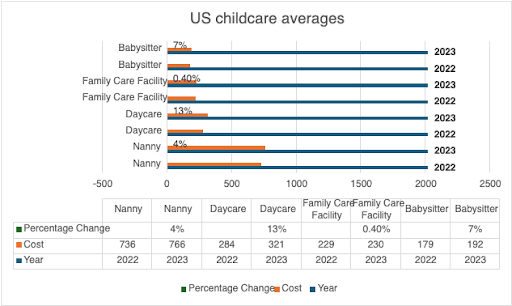Working parents who have small kids may spend a lot of money on different cost categories such as diapers, food, and clothing. But undoubtedly, child care cost is the most important and biggest expense that working parents need to manage. Depending on their neighborhood and the number of kids in early care, child care costs can exceed any household's average monthly mortgage payments.
Let's look at the statistics:

Data courtesy: care.com
That cost varies by state. As a result, for average-income parents, affording child care on a single income may become quite difficult. To solve this issue parents may determine monthly budgets, explore vivid child care options, and evaluate them. Once they know how much they can afford child care, they can discover the most affordable and trustworthy hacks.
In this article, I'll share several of the cheapest and most affordable childcare hacks and provide many ways to save money.
Affordable child care hacks for parents in 2024
1. Start planning early
Many parents search for childcare services months in advance. I suggest parents should start searching for child care services a year before they need them. The same idea applies to finding a full-time babysitter or an after-school program.
If you need school-year care, start searching during early summer. If you are looking for summer daycare, it is better to start during early spring. Cheaper options are usually booked up first. So, do not wait.
Check out Early Head Start (for babies and toddlers under 3) and Head Start (for 3- and 4-year-olds), two federally endorsed preschool programs. They are tailored especially for low-income households.
2. Know local rates of child care services
Child care costs may vary widely by community. Child care is more expensive in high-cost places. If you want to avoid overpaying for child care, then you should choose your neighborhood carefully.
3. Explore child care options
You may choose in-home or part-time child care, depending on your income and household budget. Perhaps a nanny share is ideal for your care needs. Learn about all child care options and rates. Check out the options below:
Family child care
In-home child care or family child care can save you a lot of money. It takes place in a caregiver’s home, so the caregiver gets more convenience. The kids can also experience a homely atmosphere. As a parent, you should ensure that the child care is state-licensed.
On-site childcare services
An on-site childcare takes place at your workplace. It can provide you peace of mind as you can see your kids throughout the day while working. On-site daycare is cheaper than community daycare.
Part-time nanny or babysitter
You can hire a part-time nanny or babysitter for your kids. This type of service can provide after-school pickup, schoolwork, extracurricular activity driving, supper prep, and basic cleaning services.
Teens for after-school childcare
Hiring a reliable teen babysitter for after-school hours can be cheaper than part-time daycare labor. Teens leave school early and can keep younger kids busy or remind them to do their homework.
Shared child care assistance
Set up a nanny to share with friends or neighbors who also require child care. One nanny will watch the kids from both households, and you split the total child care expenses with your friends or neighbors.
Paul Eidner, COO, CarnoSport®, supported this childcare cost-saving idea. He said nanny sharing or au pairs work better for younger kids. Families can split the cost of an in-home nanny or au pair instead of full-time center care. Each family receives in-home care at a lower cost. The nanny also earns more for caring for many children. It's a win-win and creative alternative to exorbitant childcare costs.
Childcare swapping based on days or weeks
Considering your work schedules and parenting styles, you and your friends or neighbors may swap child care. This way, you both may get reliable, cost-free child care. For example - you take the responsibility for all the kids from both households for three days, and your neighbor or friend takes the rest for two days. You may also switch weeks if possible.
4. File for child care tax credit
You can use the child care tax credit if your employer doesn't provide an FSA. This credit allows itemization of up to $3,000 per child annually, up to $6,000 per household. You can apply the tax credit to a percentage of your itemized expenses. Most families save 20%, saving up to $600 for one child and $1,200 for more than one child.
If you utilize an FSA and a tax credit, the FSA money goes to the tax credit cap first. When using $5,000 from an FSA, you can deduct only $1,000 for child care tax credit.
5. Get a Dependent Care Account
You can save up to $5,000 tax free for childcare if your employer offers a Flexible Spending Account (FSA). You can save $2,000, depending on your marginal tax rate. Daycare, preschool, and summer day camps (but not overnight programs) are also covered by the FSA.
Keep aside the amount you need because end-of-year account money will be forfeited. You also need to maintain all the records for receiving reimbursement. For married couples, one spouse can usually contribute to an FSA account. The only exception is if you and your spouse file separate taxes, then both of you can invest $2,500 each in a Dependent Care Account.
6. Claim the Earned Income Tax Credit (EITC)
Low income families and moderate income parents with qualified children can claim the EITC. The tax credits can be a few hundred to several thousand, depending on your filing status and number of children. Check the IRS website for EITC eligibility and filing instructions.
7. Explore state assistance child care subsidies
The federal government has child care assistance programs for every state. This program helps eligible low-income parents and primary caregivers with children under 13 (or 19 if incapable of self-care or under court supervision). The program provides child care assistance for work training or education in some states.
8. Check for free pre-K in your state or city
Check to see if your city or state offers a free preschool program for kids ages 3 to 5. This type of free program helps prepare your child for kindergarten and is usually suitable for low-income households.
9. Receive Military and Department of Defense assistance
Find federal government programs that help Military and DOD families pay for child care. You must be an active military personnel.
10. Explore nonprofit options
Churches, YMCAs, community centers, and other nonprofit organizations may offer low-cost child care in your community. Working parents often find affordable child care at these places. Such nonprofit child care centers receive federal, state, and private funds.
11. Speak with the human resources department
Companies are now providing financial assistance to the child care burden working parents face. Some employers reimburse the money working parents spend on child care. Work-sponsored backup care programs, like Care for Business, connect employees to low—or no-cost in-center and in-home child care.
Contact the human resources department to avoid missing out on these money-saving benefits. If your workplace does not have such facilities, discuss the matter with the HR department to initiate a backup care program or other employment benefits.
12. Change your work schedule
Many jobs now offer flexible scheduling, so you can adjust your work time and just pay for part-week child care. If part-time work isn't possible, ask your employer about a flexible schedule.
If you and your spouse have different work schedules, you may always watch the kids and avoid child care expenses.
13. Request employer to allow work-from-home
You may request your employer to allow remote working or work-from-home. If a permanent set-up is not possible, ask for remote work two or three times a week. Working from home may save transportation expenses, clothing, and other office expenses, along with your precious time spent moving to and from the office. This way, you may devote more time to work.
14. Request family members for support
If you live near grandparents or aunts and uncles, ask them to watch your kids in your absence. You should be flexible with your requests and don't make any demands on your family members. Remember, they are not asking for any money, so be polite while requesting. If you want, you may pay the family member a small fee for his/her assistance and free childcare. Also, consider any transportation and food costs associated with your child's daycare.
Conclusion
Every child care scenario is different. So, you need to handle each with a different mindset. Be flexible and open to the options you have. It can benefit your kids and family to the highest level. Above all, don't cut corners on child care. You should hire the best child care you can afford. It will ensure your children are handled and cared for by someone experienced, nurturing, responsible, and reliable.













